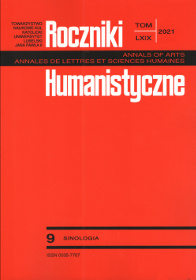Chinese Gardens as a Nativity Scene: Matteo Ripa’s Description of the Kangxi Emperor’s Changchun Garden in Beijing
Abstract
This article examines the description of the Changchun Garden in eighteenth-century Beijing, featured in Matteo Ripa’s Storia della Fondazione della Congregazione e del Collegio de’ Cinesi. An Italian missionary at the court of the Kangxi Emperor, Ripa had a chance to see and describe both the imperial parks and the intricacies of Chinese court etiquette. His detailed account, a precious source of information on the Changchun park, was accompanied by commentaries aimed at explaining the differences between “European” and “Chinese” aesthetic values. Therefore, this article offers a critical analysis of the account as a historical source, discussing the accuracy of some of the details described by Ripa, and subsequently provides an interpretation of the way he perceived Chinese parks, with an emphasis on his explanations of the “Chinese style” of laying out gardens. Finally, the last part of the article is dedicated to a comparison between a Neapolitan nativity scene (presepio) and the Qing gardens as drawn by Ripa at the end of his description, in order to demonstrate the “artificial naturalness” of Chinese parks.
References
Barmé, Geremie. “The Garden of Perfect Brightness, Life in Ruins.” East Asian History, no. 11, 1996, pp. 111-158.
Behdad, Ali. “The Eroticized Orient: Images of the Harem in Montesquieu and His Precursors.” Stanford French Review, vol. 2-3, no. 13, 1989, pp. 108-126.
Brown, Tony C. “Joseph Addison and the Pleasures of ‘Sharawadgi’.” ELH, vol. 74, no. 1, 2007, pp. 171-93.
Clunas, Craig. Fruitful Sites: Garden Culture in Ming Dynasty China. Duke University Press, 1996.
Corradini, Piero. “The Legitimization of the Qing Dynasty.” Central Asiatic Journal, vol. 46, no. 1, 2002, pp. 112-127.
D’Aponte, Mimi Gisolfi. “Presepi: A Neapolitan Christmas Ritual.” Performing Arts Journal, vol. 2, no. 2, 1977, pp. 49-60.
Demel, Walter. “How the Chinese Became Yellow: A Contribution to the Early History of Race Theories.” China in the German Enlightenment, edited by Battina Brandt and Daniel Purdy. Scholarly Publishing Division, 2016, pp. 20-59.
Dray-Novey, Alison. “Spatial Order and Police in Imperial Beijing.” The Journal of Asian Studies, vol. 52, no. 4, 1993, pp. 885-922.
Ermenc, J. J. “The Machine of Marly.” The French Review, vol. 29, no. 3, 1956, pp. 242-244.
Fatica, Michele, and Yue Zhuang. “Copperplates Controversy: Matteo Ripa’s Thirty-Six Views of Jehol and the Chinese Rites Controversy.” Entangled Landscapes: Early Modern China and Europe, edited by Yue Zhuang and A.M. Riemenschitter. NUS Press, 2017, pp. 144-186.
Furuya Akihiro (古屋昭弘), “Mindai kanwa no isshiryō: Ricci, Ruggieri no Hinshu mondō shigi” (‘明代官話の一資料:リッチ・ルッジエールの「賓主問答私擬」” [“The First Information about the Ming Guanhua: Ricci and Ruggieri’s Baozhu wenda sini’]. 東洋学報 Tōyō gakuhō (Toyo University Academic Journal), vol. 70, no. 3-4, 1989, pp. 1-25.
Göçek, Fatma Müge. East Encounters West: France and the Ottoman Empire in the Eighteenth Century. Oxford UP, 1987.
Gray, Basil. “Lord Burlington and Father Ripa’s Chinese Engravings.” The British Museum Quarterly, vol. 22, no. 1/2, 1960, pp. 40-43.
Grosrichard, Alain. Structure du sérail: La fiction du despotisme asiatique dans l’occident Classique. Seuil, 1979.
Hanan, Patrick, editor. Treasures of the Yenching: Seventy-Fifth Anniversary of the Harvard-Yenching Library [Exhibition Catalogue]. Chinese University Press, 2003.
Lach, Donald F., Asia in the Making of Europe, vol. 1. University of Chicago Press, 1965.
Liu, Yaxuan 刘亚轩. “Qing chu laihua chuanjiaoshi Ma Guoxian yu zhongxi meishu jiaoliu 清初来华传教士马国贤与中西美术交流.” Neimenggu nongye daxue xuebao (shehui kexue ban) 内蒙古农业大学学报(社会科学版), vol. 10, no. 6, 2008, pp. 329-331.
Mitchell, Timothy. Colonising Egypt. University of California Press, 1988.
Millar, Ashley Eva. “Revisiting the Sinophilia/Sinophobia Dichotomy in the European Enlightenment through Adam Smith’s Duties of Government.” Asian Journal of Social Science, vol. 38, no. 5, 2010, pp. 716-737.
Pan Guxi 潘谷西, Zhongguo jianzhu shi 中国建筑史. Zhongguo Jianzhu Gongye Chubanshe 中国建筑出版社, 2009.
Said, Edward. Orientalism. Pantheon Books, 1979.
Shi, Zhan. “L’Image de la Chine dans la pensée européenne du XVIII siècle : de l’apologie à la philosophie pratique.” Annales historiques de la Révolution française, no. 247, 2007, pp. 93-111.
South, Coblin, W. “Notes on the Sound System of Late Ming Guanhua.” Monumenta Serica, no. 45, 1997, pp. 261-307.
Thacker, Christopher. “La Manière De Montrer Les Jardins De Versailles, by Louis XIV and Others.” Garden History, vol. 1, no. 1, 1972, pp. 49-69.
Shatzman Steinhardt, Nancy. Chinese Architecture: A History. Princeton University Press, 2019.
Wang, Xun 王逊, Zhongguo meishu shi 中国美术史. Renmin Meishu Chubanshe 人民美术出版社, 2018.
Wu, Ge 舞格. Qing wen qi meng 清文启蒙. N.p., 1730.
Xue, Xiaofei 薛晓飞, Zhou Hong 周虹, Zhao Jiuzhou 赵九洲, and Liu Min 刘敏. “Yuanming san yuan zhi zaoyuan yishu qiantan – Changchun yuan pian 圆明三园之造园艺术浅探—长春园篇,” Laiyang nongxueyuan xuebao 莱阳农学院学报, vol. 17, no. 3, 2000, pp. 173-186.
Zhou, Weiquan 周维权, Zhongguo gudian yuanlin shi 中国古典园林史. Qinghua Daxue Chubanshe 清华大学出版社, 2008.
Copyright (c) 2021 Roczniki Humanistyczne

This work is licensed under a Creative Commons Attribution-NonCommercial-NoDerivatives 4.0 International License.





